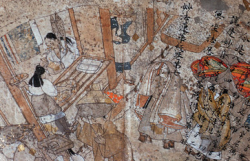The End of the Heian Period

The Heian period is known as Japan’s Golden Age of peace. But despite the glittering imperial court, problems were brewing that would bring an end to the Heian period.
Aristocrats in Heian-kyo lived very well, but in Japan’s rural areas most people were quite poor. The peasants’ farming and other work supported Heian-kyo’s rich. Even so, the wealthy looked down on the poor and ignored their problems.
While the rich focused on culture in Heian-kyo, events in the countryside began to weaken the Heian court. The practice of giving large estates to top nobles slowly reduced the emperors’ power. Those who owned these estates paid no taxes. After a time, tax-free land was quite common. The government could no longer collect enough taxes to support the emperor.
Japan’s rulers began to lose control. Bandits roamed the countryside. People of different religions began to band together to attack and rob each other. The government was now too weak to supply law enforcement. Estate owners created their own police and armies to protect their lands. The profits from landowners’ estates went to paying the warriors instead of supporting the emperor.
By the 12th century, the power of some local lords rivaled that of the weakened imperial government. Fighting broke out over control of the land. Meanwhile, various clans struggled for power in the capital. By 1180, there was civil war in Japan.
In 1185, Minamoto Yoritomo, the head of a military family, seized power. A new era began in which military leaders controlled Japan. You will read more about this era in the next lesson.
Aristocrats in Heian-kyo lived very well, but in Japan’s rural areas most people were quite poor. The peasants’ farming and other work supported Heian-kyo’s rich. Even so, the wealthy looked down on the poor and ignored their problems.
While the rich focused on culture in Heian-kyo, events in the countryside began to weaken the Heian court. The practice of giving large estates to top nobles slowly reduced the emperors’ power. Those who owned these estates paid no taxes. After a time, tax-free land was quite common. The government could no longer collect enough taxes to support the emperor.
Japan’s rulers began to lose control. Bandits roamed the countryside. People of different religions began to band together to attack and rob each other. The government was now too weak to supply law enforcement. Estate owners created their own police and armies to protect their lands. The profits from landowners’ estates went to paying the warriors instead of supporting the emperor.
By the 12th century, the power of some local lords rivaled that of the weakened imperial government. Fighting broke out over control of the land. Meanwhile, various clans struggled for power in the capital. By 1180, there was civil war in Japan.
In 1185, Minamoto Yoritomo, the head of a military family, seized power. A new era began in which military leaders controlled Japan. You will read more about this era in the next lesson.
Room 7 Questions
1. What should your attitude toward the poor be if you want the aristocrats to accept you?
2. List three reasons the Heian period came to an end.
3. Quickly sketch and label a drawing to illustrate an important idea about the end of the Heian period.
2. List three reasons the Heian period came to an end.
3. Quickly sketch and label a drawing to illustrate an important idea about the end of the Heian period.

